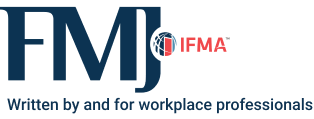Ask the Experts
Staying Sharp: FM for the new workspace

If empty office buildings were emblematic of the pandemic years, the hybrid office symbolizes all that has changed in business life post COVID-19. The new office allows workers to come together dynamically on demand without being tethered to permanent workstations. It allows them to interact online, offline or in hybrid mode, in company owned spaces, shared or co-working spaces. Contractors and gig workers plug into this mosaic per need. The era of the office-bound day job is officially over. As businesses transform this way, the infrastructure supporting them, including facility management services, must also change.
After a slump caused by the COVID-19 years, the outlook for the FM market is looking up. The worldwide facility management market is projected to grow from $1.2 trillion in 2022 to $1.8 trillion by 2029, a compound annual growth rate (CAGR) of 5.7 percent between 2022 and 2029. The North American market reflects this growth curve – the FM market in this geography is expected to grow by $122.97 billion during 2021-2025, progressing at a CAGR of more than 9 percent.
What is driving this growth?
A key driver is the rising levels of outsourcing in building management and the value proposition offered to building owners. Comprehensive contracts that run the gamut of technical maintenance, facilities maintenance and repair, catering and hospitality services, landscaping and cleaning services, as well as a broad variety of support services, are defining the market. The focus is on integrated contracts that consolidate multiple services with a single vendor, minimizing cost and redundancy.
Within the larger FM market, cleaning and maintenance services remain important. In a 2022 CMM U.S. survey of 291 in-house service providers and FMs, nearly 40 percent of the respondents stated that they spent between 20 percent and 30 percent of their operating budget on cleaning/maintenance equipment and supplies. This spend line has stayed steady over the last five years, indicating that core cleaning services will remain the backbone of facility management contracts. The CMM survey also reported that 2022 operating budgets improved over 2021, with just 48 percent of respondents reporting a flat/decreased budget (down from 71 percent in 2021). The number of respondents who reported an increase in operating budget in 2022 doubled from 20 percent in 2021 to 41 percent. This bodes well for FM budgets.
A report from EMR projects that the cleaning services market, worth $69.8 billion globally in 2022, is expected to grow at a CAGR of 6.4 percent during 2023-28 to reach $101.28 billion by the end of that period. This segment, therefore, appears to be growing faster than the overall FM market.
A significant driver for this is the growth of the healthcare industry.
The pandemic has accelerated public and private spending on healthcare. In the U.S. alone, national healthcare spending is projected to grow at an average rate of 5.4 percent per year during 2019-2028, to reach around $6.1 trillion by 2028, according to data published by the Centers for Medicare and Medicaid Services (CMS). This is expected to trigger downstream demand for waste management, cleaning and disinfection services.
Tech rising
The transformational powers of technology are at play in the FM universe as well as the cleaning/janitorial services space. Automated systems that can perform common tasks using preset schedules are replacing the traditional reliance on manual cleaning.
The scope of such increasing automation also extends to software platforms to manage field operations that help companies manage tasks from scheduling to contract management to billing. A key value proposition delivered by such systems is increased data-driven decision-making. Janitorial companies are beginning to see the value of data and metrics – from real-time information about supplies and scheduling to the longer-term analysis of pattern and trends across the business.
Going forward, the data centric management of such services is expected to get a boost with IoT. IoT applications could range from sensors that track dispenser capacities to waste and recycling systems that send out alerts for collection when bins are full. While IoT will effectively make buildings smarter at the infrastructure and management levels, cleaning service providers require software systems that integrate with new technology.
Janitorial companies are beginning to see the value of data and metrics – from real-time information about supplies and scheduling to the longer-term analysis of patterns and trends across the business.
Tech to manage flexible business models
While technology is one lever for the business, changing service models is a very important second for this industry at the current point in time. The new business models in the facility management space today need effective IT systems that integrate the activities of aggregators, end customers and sub-contractors, even as they manage customers through a single interface. While end customers may hand off full-scope contracts to one vendor, the delivery model behind that single window service is complex. Facility management providers are moving towards an ecosystem driven model that involves a mosaic of franchises and sub-contractors that deliver based on preset central service standards.
An automated information-driven universe needs accurate data flowing in on time. In a business where service delivery may be remotely executed by franchises/sub-contractors in multiple locations, FMs and end customers need timely visibility on work order execution or delays to facilitate decision making. To get there, they need facility management systems that are organically mobile, where data updates from multiple devices feed into a visible information pipeline that can be tapped for decision making.
While mobility will be key for work reporting and inspections, it is part of the broader shift to automation required across the enterprise.
FM providers are moving towards an ecosystem driven model that involves a mosaic of franchises and sub-contractors that deliver based on preset central service standards.
While such a model drives efficiency and cost reduction for the facility manager (and the end customer due to competitive pricing driven by such efficiency), making it work on the ground requires an information system that manages work allocation, monitoring and billing. The last piece – billing - is key as revenue leakages continue to be a huge challenge for facility management companies, and more so when service execution is done remotely by third parties. Therefore, information systems must seamlessly integrate operations such that all users feed, update and use the same data. In addition, all records must be visible across the system to ensure zero inconsistencies in a business that operates on a single source of truth. This is needed for companies to have full visibility of their assets, resources, workforce and service partners.
Mobility first
While mobility will be key for work reporting and inspections, it is part of the broader shift to automation required across the enterprise. This spans all critical functions - from fulfillment automation that provides visibility into work orders and field level quality control to automation of the order-to-execution-to-cash cycle in finance/accounting and real-time tracking of people deployment to control revenue leakage.
Interactions with vendors and customers can also be automated through service portals that field enquiries. While customers need an interface to track and monitor orders and service requests, the vendor interface needs to manage supply orders, track service request approvals, and monitor fulfillment.
Can one size fit all?
Given these specific challenges FM businesses face, the sector can no longer afford to deploy generic business information systems not designed to address them. Customizations on generic platforms, while expedient are, at best, tactical and do not bring industry best-in-class practices to the table. Moreover, extensive customization is almost always required on generic platforms. Instead, FM businesses would find better use of their budgets by investing in platforms tailored to meet the demands of this industry. For instance, the platform must take care of the intricacies of the business processes, KPIs and integration with ecosystem players such as franchisees, subcontractors and customers. This is critical to keeping their businesses in good order, even as they make their customer workspaces shine.
Facility management businesses would find better use of their budgets by investing in platforms tailored to meet the demands of this industry.
A comprehensive solution framework should be as below:
Implementing such a system can generate copious benefits for facility management businesses such as:
-
Effort reduction by 50 percent: Complete automation from customer contract assignment to service provider lifecycle
-
Fulfillment Automation: Ensures visibility of work orders and quality control at the field level
-
Optimization and Innovation: Native mobility and customer/supplier portal capabilities
-
Accounting Process Automation: Up to 85 percent back-office man-hour reduction with automation right through the order-to-execution cycle
-
Finance Automation: Support for customer billing, franchise billing, pay-to-pay, adjustments and processing of missed services.
-
Invoice Automation: Full functional system with support for ad funds, loans and advances to franchise, insurance, worker’s compensation and loyalties

Rupesh Lahane is a Digital Transformation expert and has more than 16 years of experience in several enterprise technologies including ERP solutions, conversational bots, IoT, predictive analytics and artificial intelligence and machine learning. As a director and head of solution advisory at Ramco Systems Corporation, he enables companies through their digital transformation journey. Lahane holds a master’s degree in business administration, an executive certification from Indian Institute of Management and is specialized in the field of digital transformation from Indian School of Business. He is an active member of IFMA’s Dallas/Fort Worth Chapter and the Information Technology Community.
References
fortunebusinessinsights.com/industry-reports/facility-management-market-101658
businesswire.com/news/home/20210413005559/en/North-America-Facility-Management-Services-Market-2021-2025-Market-is-Poised-to-Grow-by-122.97-Billion---ResearchAndMarkets.com
cmmonline.com/articles/fmsurvey2022
expertmarketresearch.com/reports/cleaning-services-market
healthaffairs.org/doi/10.1377/hlthaff.2020.00094
Read more on Real Estate
Explore All FMJ Topics









